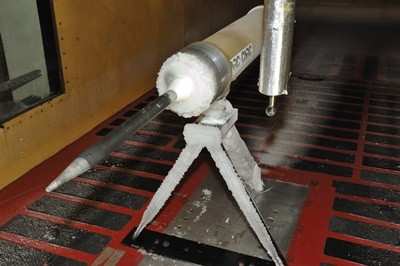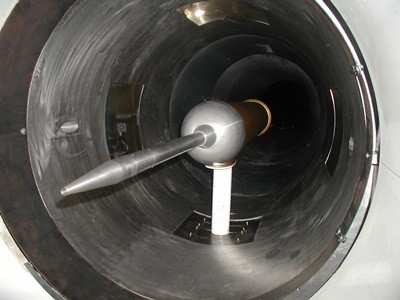NRC Aerospace Announces Advancement In Icing Research
The National Research Council Canada Institute for Aerospace
Research on Monday announced a significant advance in icing
research. NRC Aerospace researchers have developed an isokinetic
probe that can measure total water content when flying at altitude
through clouds with ice crystals. This probe is the only fully
functioning device of its kind in the world and represents a
significant step forward in the effort to characterize and fully
understand the total water content present in clouds with ice
crystal conditions.

NRC Isokinetic Probe
Since the 1950s, ice crystal conditions have been identified as
a potential problem for aircraft, but there has been no real
understanding of this phenomenon occurring at high altitudes. Over
the last few years, however, NRC Aerospace researchers have been
building on past research capabilities and collaborating with
research partners to gain a greater understanding of the effects of
ice crystal ingestion on the safe operation of large aircraft
engines. This effort included developing new and accurate sensors
to fully characterize clouds containing ice crystals that are
considered a threat for safe aircraft operations.
A wide variety of cloud liquid water content probes have already
been developed, but none appear well suited to ice crystal
conditions. In fact, existing probes typically underestimate cloud
total water content. The NRC-designed and built probe, however,
samples the cloud isokinetically and employs an NRC-designed
evaporator that ensures an accurate total water content
reading.
NRC Aerospace researchers have tested the probe extensively in
NRC facilities, including the Research Altitude Test Facility under
simulated flight conditions that included ice crystals in the range
of 70 to 270 microns in concentrations up to 15 grams per cubic
metre. Total water content readings are proving accurate. Flight
testing of the probe in ice crystal conditions is planned for
2011.

Isokinetic Probe In Test Tunnel
This research builds on NRC Aerospace's capability demonstrated
last year to create significant ice accretion in a simulated
aircraft engine test rig with frozen ice crystals in air
temperatures above 0ºC. This collaborative project with the
Boeing Company to prove that ice crystals could form in an aircraft
engine at temperatures above the melting point of ice represented a
significant step forward in the understanding of how ice builds up
in aircraft engines under ice crystal conditions.
Using the same rig as in the Boeing collaboration, NRC Aerospace
researchers have also demonstrated that air data probes can
accumulate ice under certain conditions. They have observed that
these probes can handle conditions to a certain threshold, but fail
once that threshold has been exceeded. Airworthiness authorities
are currently reviewing the test procedures for these and may
modify the regulations as required.
"We are attacking the ice crystal problem from all angles,
building on past successes and moving into a new understanding of
the problem," said NRC gas turbine laboratory director Dr. Ibrahim
Yimer. "With these advances, we hope we can begin the process of
modeling the phenomenon reasonably accurately at sea level in order
to predict and develop mitigating solutions, thereby ensuring the
safety of the traveling public."
 ANN's Daily Aero-Term (04.26.24): DETRESFA (Distress Phrase)
ANN's Daily Aero-Term (04.26.24): DETRESFA (Distress Phrase) ANN's Daily Aero-Linx (04.26.24)
ANN's Daily Aero-Linx (04.26.24) Airborne 04.22.24: Rotor X Worsens, Airport Fees 4 FNB?, USMC Drone Pilot
Airborne 04.22.24: Rotor X Worsens, Airport Fees 4 FNB?, USMC Drone Pilot Airborne 04.24.24: INTEGRAL E, Elixir USA, M700 RVSM
Airborne 04.24.24: INTEGRAL E, Elixir USA, M700 RVSM Airborne-NextGen 04.23.24: UAVOS UVH 170, magni650 Engine, World eVTOL Directory
Airborne-NextGen 04.23.24: UAVOS UVH 170, magni650 Engine, World eVTOL Directory




